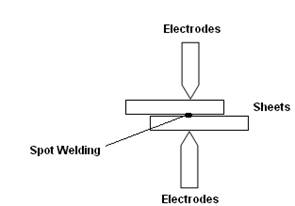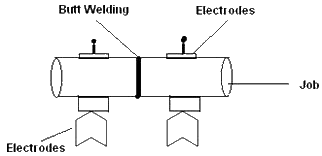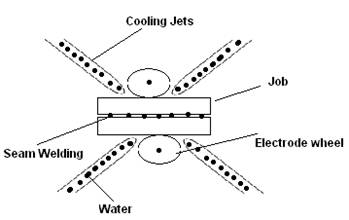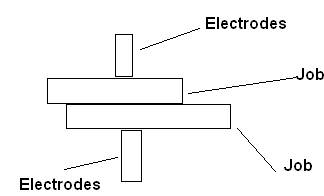Resistance Welding
Two pieces of metal may be welded together by passing large current of 1000A to 100,000A through these pieces. These pieces force together between the two electrodes of the welding machine. The heat produce in the welding machine is
H = I2 RT Joules
Where
I = Current in ampere
R = Resistance between the two Pieces
T = Time during which current flow (in seconds)
Since there must be resistance to current flow between the two metal pieces where most of welding heat is produced. This value of the resistance on the metal that is being welded, steel has a high resistance so the welding heat is easily produced, while aluminum has low resistance therefore the welding heat is harder to obtain.
Types of the resistance welding
There are the following types of the resistance welding.
Spot Welding

It is done by clamping two or more pieces of metal in the form of sheet. When we weld two sheets, we place these pieces between the two welding electrodes, the electrodes tips are made of copper, the welding current depends on the thickness and the composition of the sheets.
Butt Welding

In this welding, one bar is hold in fixed clamp and the other in moving clamp. The two bars are brought together as shown in the figure. The heating (welding) current is produce through the welding transformer to rise the temperature of the job, when the pieces are welded, the hold of the clam is released. This type of welding is used to weld pips, wires and railway tracks.
Seam Welding

In this type of welding the overlapping sheets of metal are welded either along continuous line by moving the sheets between the two electrodes wheel, through which the welding current flows in short or long intervals.
Projection Welding

In projection welding we use electrodes inside of pointer for the transfer of heat. The heat is produced in both electrodes at the location where the welding is desired at the same time. The projection welding is shown in the following figure.
Sequence Timer
To control the spot welding machine a sequence timer has to measure the time for welding in four steps as shown in the given figure.
In first the foot switch is closed and the squeeze time prevents the electrodes to build up the right pressure on the work piece. The weld time is the time during which the welding current flow, after the welding current stops, the electrodes continue pressure on the metal pieces during the hold time, in which the weld become hard. At last the electrodes decrease the pressure on the metal pieces in separate to each other.

